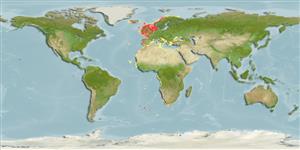Common names from other countries
Environment: milieu / climate zone / depth range / distribution range
Οικολογία
; Υφάλμυρο; εύρος βάθους 0 - 200 m (Ref. 435), usually 6 - 40 m (Ref. 435). Temperate, preferred 12°C (Ref. 107945)
Eastern Atlantic and the Mediterranean: from northwest Morocco to Atlantic coast of Europe.
Length at first maturity / Μέγεθος / Βάρος / Age
Maturity: Lm 11.0 range ? - ? cm Max length : 20.0 cm CL αρσενικό/απροσδιόριστο; (Ref. 435)
This is the most important edible crab fishery in Europe (Ref. 2762). Maximum depth from Ref. 106870. Occurs from the intertidal area to a depth of 100 m, common at depths 6 to 40 m (Ref. 435). Regularly found just above low tide mark. Found in an estuary (Ref. 106870). Inhabits rocky or sandy bottom (Ref. 96377). Carnivore; trophic level 3.1 (Ref. 96418).
Members of the order Decapoda are mostly gonochoric. Mating behavior: Precopulatory courtship ritual is common (through olfactory and tactile cues); usually indirect sperm transfer.
Fischer, W., G. Bianchi and W.B. Scott (eds.). 1981. (Ref. 435)
IUCN Red List Status (Ref. 130435)
CITES status (Ref. 108899)
Not Evaluated
Not Evaluated
Human uses
αλιεία: Εμπορικό(ά)
FAO - αλιεία: landings, species profile | FishSource | Η θάλασσα γύρω μας
Εργαλεία
Διαδικτυακές πηγές
Estimates based on models
Preferred temperature
(Ref.
115969): 8.1 - 12.5, mean 10.4 (based on 518 cells).
Ελαστικότητα
Υψηλό, ελάχιστος χρόνος για διπλασιασμό πληθυσμού < 15 μήνες (K=0.24-0.46).
Prior r = 0.46, 95% CL = 0.31 - 0.69, Based on 2 data-limited stock assessments.
Vulnerability
Low vulnerability (10 of 100).
